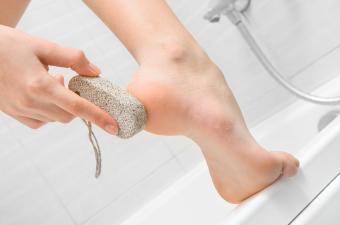
If you're a skincare novice, the word "slugging" is probably not in your vernacular. Or perhaps you've heard the term but have not been totally clear on what it means. The skincare technique has blown up in 2022, with beauty influencers everywhere touting its benefits. But what is slugging and is it actually worth the hype? We're breaking down what this viral skincare trend is really about and whether or not your skin can actually benefit from it.
What Is Slugging?
Slugging is a skincare method that involves applying a thick layer of occlusive (like Vaseline) as the last step in your skincare routine before bed. When applied correctly, you'll end up with a thick, slimy layer similar to that of well, a slug. The process, as far as skincare techniques go, is simple, inexpensive, and consistently touted as a "holy grail" trick for adding an overnight boost of hydration to your skin.
"Slugging can be really beneficial for normal to dry skin or those with chronic dry skin," explains Vicky Larsen, a licensed esthetician and founder of the skincare line bogl Supportive Skincare.
Benefits of Slugging
Occlusives like petroleum jelly are used as sealants to protect your skin from external elements. By adding this thick layer, you create a barrier that seals in all of the skincare products you just applied as well as locking in hydration. Not only will slugging maximize the benefits of your skincare routine, but it prevents your skin from losing water. Slugging can be especially beneficial if you're suffering from a compromised skin barrier and in need of some deep healing.
How to Slug Your Skin
Sounds promising, right? But, you may be wondering how exactly to delve into the slugging world. It may seem as simple as scooping out some petroleum jelly and slapping it on, but there is an art to getting the most out of your slugging routine.
- Deep cleanse your face. If you've been wearing makeup, double cleanse to ensure there's no residue of any cosmetics on your skin.
- Apply your usual skincare routine. Start with your toner, then pat in your serums or treatments, and finish off with your usual moisturizer.
- Apply your occlusive. While your skin is still a little damp from the last product you applied, scoop out a pea-sized amount of your petroleum jelly or occlusive lotion of choice and apply a thick layer onto your skin. There's no need to rub it in, just make sure you have an even layer on.
Slugging Tips
- Make sure to slug at night. Not only will you (probably) not want to leave the house while rocking the slimy look, but skincare healing is best done overnight. In addition, try to slug at least 30 minutes before going to bed, to allow the layer to settle into your skin before some of it inevitably rubs off while you sleep.
- Do not apply on top of active ingredients. "When you perform 'slugging' you should not apply any actives such as vitamin A, AHA's, or BHA's to the skin because they are locked in with the last step of occlusion. It could be too much [for your skin]," explains Larsen.
- Swap out your pillowcase. Replace your beloved luxe silk pillowcase for something you care a lot less about. After all, the pillowcase you use is going to get its very own slugging routine.
Does Slugging Work?
In short, yes. But not for everyone. Slugging is primarily meant for dry, dull skin types in need of additional hydration. If that's the case, you are likely to wake up with skin that feels plumper and more hydrated than ever. However, if you have oily, acne-prone skin it is likely that slugging could be too intense for you. The method works to trap your skin's natural oils, if your skin is already super-oily this step could make matters worse by clogging your pores over time, explains Larsen.
But, all good things in small doses. If you're still interested in testing it out, you can always try slugging once a week or bi-weekly to reap the benefits without clogging your pores. However, slugging is not the only way to hydrate your skin.
"The main focus [of slugging] is hydration so hyaluronic acid or other hydrating products are key," says Larsen. "If someone doesn't want to use petroleum on their face as the last step, I love to use a facial oil or ghee instead."







